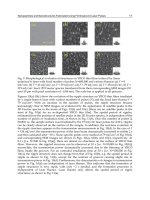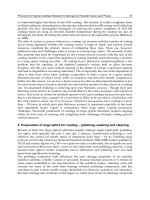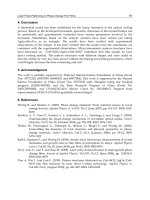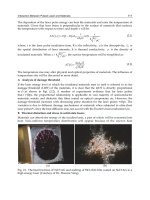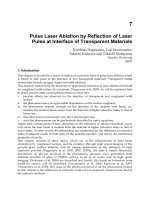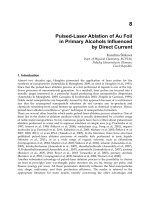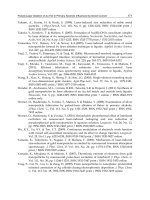Lasers Applications in Science and Industry Part 5 pdf
Bạn đang xem bản rút gọn của tài liệu. Xem và tải ngay bản đầy đủ của tài liệu tại đây (2.35 MB, 20 trang )
Effect of Pulse Laser Duration and Shape on PLD Thin Films Morphology and Structure
71
Gyorgy, E., Teodorescu, V.S., Mihailescu, I.N., Klini, A., Zorba, V., Manousaki, A., Fotakis,
C. (2004) Surface Morphology Studies of Sub-Ps Pulsed-Laser-Deposited AlN Thin
Film Journal of Materials Research volume 19, no. 3 (March 2004) pp 820-826, ISSN
2044-5326
Hergenroder, R., Miclea, M., Hommes, V., (2006) Controlling semiconductor nanoparticle
size distributions with tailored ultrashort pulses Nanotechnology volume 17, no. 16
(August 2006) pp 4065-4071, ISSN 1361-6528
Hu, Z., Singha, S., Liu, Y., Gordon, R.J. (2007) Mechanism for the ablation of Si(111) with
pairs of ultrashort laser pulses Applied Physics Letters volume 90, no. 13 (March
2007) pp 131910_1-3, ISSN 1077-3118
Itina, T. E., Shcheblanov, N. (2010) Electronic excitation in femtosecond laser interactions
with wide-band-gap materials Applied Physics A: Materials Science & Processing
volume 98, no. 4 (March 2010) pp 769–775, ISSN 1432-0630
Jegenyes, N., Toth, Z., Hopp, B., Klebniczki, J., Bor, Z., Fotakis, C. (2006) Femtosecond
pulsed laser deposition of diamond-like carbon film: The effect of double laser
pulses Applied Surface Science volume 252, no. 13 (April 2006) pp 4667-4671, ISSN
0169-4332
Judson, R.S., Rabitz, H. (1992) Teaching lasers to control molecules Physical Review Letters
volume 68, no. 10 (March 1992) pp 1500-1503, ISSN 1079-7114
Kaganov, M. I., Lifshitz, I. M., Tanatarov, L. V. (1957) Relaxation between electrons and the
crystalline lattice Soviet Physics – JETP volume 4 (1957) pp 173-180, ISSN 0038-5646
Klini, A., Loukakos, P.A., Gray, D., Manousaki, A., Fotakis, C. (2008) Laser Induced Forward
Transfer of metals by temporally shaped femtosecond laser pulses Optics Express
Vol. 16, No. 15 (July 2008) pp 11300-11309, ISSN 1094-4087
Lozovoy, V.V., Xu, B., Coello, Y., Dantus, M. (2008) Theoretical development of a high-
resolution differential-interference-contrast optic for x-ray microscopy Optics
Express volume 16, no. 2 (January 2008) pp 592-597, ISSN 1094-4087
Luculescu, C.R., Miyake, H., Sato, S. (2002) Deposition of BN thin films onto Si(1 0 0)
substrate by PLD with nanosecond and femtosecond pulses in nitrogen gas
background Applied Surface Science volume 197–198 (September 2002) pp 499–504,
ISSN 0169-4332
Mihailescu, I.N., Hermann, J. (2010) Laser Plasma Interactions Laser Processing of Materials:
Fundamentals, Applications, and Developments, Ed. P. Schaaf, pp 51–90, Springer
Series in Materials Science, ISBN 978-3-642-13280-3, Springer Heidelberg Dordrecht
London New York
Miller, J.C. (Ed.) (1994) Laser Ablation Principles and Applications, Springer-Verlag, ISBN
3540575715 9783540575719 Berlin
Miller, J. C., Haglund, R.F. (Eds.) (1998) Laser Ablation and Desorption, Academic Press, ISBN
0124759750 9780124759756, San Diego
Millon, E., Albert, O., Loulergue, J. C., Etchepare, J. C., Hullin, D., Seiler, W., Perriere, J.
(2000) Growth of heteroepitaxial ZnO thin films by femtosecond pulsed-laser
deposition Journal of Applied Physics volume 88, no. 11 (December 2000) pp 6937-
6939; ISSN 1089-7550
Lasers – Applications in Science and Industry
72
Muller, G., Krotz, G., Niemann, E. (1994) SiC for sensors and high-temperature electronics
Sensors and Actuators A: Physical volume 43, no. 1-3 (May 1994) pp 259-268, ISSN
0924-4247
Okoshi, M., Higashikawa, K., Hanabusa, M. (2000) Pulsed laser deposition of ZnO thin films
using a femtosecond laser Applied Surface Science volume 154–155 (February 2000)
pp 424-427, ISSN 0169-4332
Palmour, J. W., Edmond, J.A., Kong, H. S., Carter Jr., C.H. (1993) 6H-silicon carbide devices
and applications Physica B: Condensed Matter volume 185, no 1-4 (April 1993) pp
461-465, ISSN 0921-4526
Papastathopoulos, E., Strehle, M., Gerber, G. (2005) Optimal control of femtosecond
multiphoton double ionization of atomic calcium Chemical Physics Letters volume
408, no. 1-3 (June 2005) pp 65-70, ISSN 0009-2614
Parker, D.S.N., Nunn, A.D.G., Minns, R.S., Fielding, H.H. (2009) Frequency doubling and
Fourier domain shaping the output of a femtosecond optical parametric amplifier:
easy access to tuneable femtosecond pulse shapes in the deep ultraviolet Applied
Physics B: Lasers and Optics volume 94, no. 2 (February 2009) pp 181–186, ISSN 1432-
0649
Perriere, J., Millon, E. Seiler, W. Boulmer-Leborgne, C. Craciun, V. Albert, O. Loulergue, J.C.
Etchepare, J. (2002) Comparison between ZnO films grown by femtosecond and
nanosecond laser ablation Journal of Applied Physics volume 91, no. 2 (January 2002)
pp 690 - 696, ISSN 1089-7550
Piñon, V., Fotakis, C., Nicolas, G., Anglos, D. (2008) Double pulse laser-induced breakdown
spectroscopy with femtosecond laser pulses Spectrochimica Acta Part B: Atomic
Spectroscopy volume 63, no. 10 (October 2008) pp 1006-1010; ISSN 0584-8547
Pronko, P.P., Cutta, S.K., Squier, J., Rudd, J.V., Du, D., Mourou, G. (1995) Machining of sub-
micron holes using a femtosecond laser at 800 nm Optics Communications volume
114, no. 1-2 (January 1995) pp 106–110, ISSN 0030-4018
Pronko, P.P., Zhang, Z., Van Rompay, P.A. (2003) Critical density effects in femtosecond
ablation plasmas and consequences for high intensity pulsed laser deposition
Applied Surface Science volume 208–209 (March 2003) pp 492-501, ISSN 0169-4332
Qian, F., Craciun, V., Singh, R.K., Dutta, S.D., Pronko, P.P. (1999) High intensity
femtosecond laser deposition of diamond-like carbon thin films Journal of Applied
Physics volume 86, no. 4 (August 1999) pp 2281-2290, ISSN 1089-7550
Ristoscu, C., Mihailescu, I.N., Velegrakis, M., Massaouti, M., Klini, A., Fotakis, C. (2003)
Optical Emission Spectroscopy and Time-of-Flight investigations of plasmas
generated from AlN targets in cases of Pulsed Laser Deposition with sub-ps and ns
Ultra Violet laser pulses Journal of Applied Physics volume 93, no. 5 (March 2003) pp
2244-2250, ISSN 1089-7550
Ristoscu, C. Gyorgy, E. Mihailescu, I. N. Klini, A. Zorba, V. Fotakis, C. (2004) Effects of pulse
laser duration and ambient nitrogen pressure in PLD of AlN Applied Physics A:
Materials Science & Processing volume 79, no 4-6 (September 2004) 927-929 ISSN
1432-0630
Ristoscu, C., Socol, G., Ghica, C., Mihailescu, I.N., Gray, D., Klini, A., Manousaki, A.,
Anglos, D., Fotakis, C. (2006) Femtosecond pulse shaping for phase and
morphology control in PLD: Synthesis of cubic SiC Applied Surface Science volume
252, no 13 (April 2006) pp 4857-4862, ISSN 0169-4332
Effect of Pulse Laser Duration and Shape on PLD Thin Films Morphology and Structure
73
Schmidt, B., Hacker, M., Stobrawa, G., Feurer, T. (n.d.) LAB2-A virtual femtosecond laser lab
Available from
Sheng, S., Spencer, M.G., Tang, X., Zhou, P., Wongchoitgul, W., Taylor, C., Harris, G. L.
(1997) An investigation of 3C-SiC photoconductive power switching devices
Materials Science and Engineering B volume 46, no. 1-3 (April 1997) pp 147–151, ISSN
0921-5107
Singha, S., Hu, Z., Gordon, R.J. (2008) Ablation and plasma emission produced by dual
femtosecond laser pulses Journal of Applied Physics volume 104, no. 11 (December
2008) pp 113520_1-10, ISSN 1089-7550
Stoian, R., Boyle, M., Thoss, A., Rosenfeld, A., Korn, G., Hertel, I. V., Campbell, E. E. B.
(2002) Laser ablation of dielectrics with temporally shaped femtosecond pulses
Applied Physics Letters volume 80, no. 3 (January 2002) pp 353-355, ISSN 1077-3118
Stoian, R., Boyle, M., Thoss, A., Rosenfeld, A., Korn, G., Hertel, I. V. (2003) Dynamic
temporal pulse shaping in advanced ultrafast laser material processing Applied
Physics A: Materials Science & Processing volume 77, no. 2 (July 2003) pp 265-269,
ISSN 1432-0630
Tanabe, T., Kannari, F., Korte, F., Koch, J., Chichkov, B. (2005) Influence of spatiotemporal
coupling induced by an ultrashort laser pulse shaper on a focused beam profile
Applied Optics volume 44, no. 6 (February 2005) pp 1092-1098, ISSN 2155-3165
Teghil, R., D’Alessio, L., Santagata, A., Zaccagnino, M., Ferro, D., Sordelet, D.J. (2003)
Picosecond and femtosecond pulsed laser ablation and deposition of quasicrystals
Applied Surface Science volume 210, no. 3-4 (April 2003) pp 307-317, ISSN 0169-4332
Trebino, R., Kane, D.J. (1993) Using phase retrieval to measure the intensity and phase of
ultrashort pulses: frequency-resolved optical gating Journal of the Optical Society of
America A volume 10, no. 5 (May 1993) pp 1101–1111, ISSN 1520-8532
Trebino, R., DeLong, K.W., Fittinghoff, D.N., Sweetser, J.N., Krumbügel, M.A., Richman,
B.A., Kane, D.J. (1997) Measuring ultrashort laser pulses in the time-frequency
domain using frequency-resolved optical gating Review of Scientific Instruments
volume 68, no. 9 (September 1997) pp 3277-3295, ISSN 1089-7623
Trebino, R. (2002) Frequency-Resolved Optical Gating: The Measurement of Ultrashort Laser
Pulses Kluwer Academic ISBN 1402070667 9781402070662, Boston
Verluise, F., Laude, V., Cheng, Z., Spielmann, C.H., Tournois, P. (2000) Amplitude and
phase control of ultrashort pulses by use of an acousto-optic programmable
dispersive filter: pulse compression and shaping Optics Letters volume 25, no. 8
(April 2000) pp 575-577, ISSN 1539-4794
Von Allmen, M., Blatter, A. (1995) Laser-Beam Interactions with Materials (2nd edition)
Springer, ISBN 3540594019 9783540594017, Berlin; Heidelberg; New York;
Barcelona; Budapest; Hong Kong; London; Milan; Paris; Tokyo
Wefers, M.M., Nelson, K.A. (1995) Analysis of programmable ultrashort waveform
generation using liquid crystal spatial light modulators Journal of the Optical Society
of America B volume 12, no. 7 (July 1995) pp 1343-1362, ISSN 1520-8540
Weiner, A. M. (2000) Femtosecond pulse shaping using spatial light modulators Review of
Scientific Instruments volume 71, no. 5 (May 2000) pp 1929-1960, ISSN 1089-7623
Zhang, Z., VanRompay, P.A., Nees, J.A., Clarke, R., Pan, X., Pronko, P.P. (2000) Nitride film
deposition by femtosecond and nanosecond laser ablation in low-pressure nitrogen
Lasers – Applications in Science and Industry
74
discharge gas Applied Surface Science volume 154–155 (February 2000) pp 165–171,
ISSN 0169-4332
Zhigilei, L. V., Garrison, B. J. (2000) Microscopic mechanisms of laser ablation of organic
solids in the thermal and stress confinement irradiation regimes Journal of Applied
Physics volume 88, no. 3 (2000) pp 1281-1298, ISSN 1089-7550
4
Laser Pulse Patterning on Phase
Change Thin Films
Jingsong Wei
1
and Mufei Xiao
2
1
Shanghai Institute of Optics and Fine Mechanics,
Chinese Academy of Sciences
2
Centro de Nanociencias y Nanotecnología,
Universidad Nacional Autónoma de México
1
China
2
México
1. Introduction
In the present chapter, we discuss the formation of microscopic patterns on phase change
thin films with low power laser pulses. The discussions are mostly based on our recent
experimental and theoretical results on the subject.
Phase change thin films are widely used as optical and electric data storage media. The
recording is based on the phase change between the crystalline and amorphous states. In
the writing process, a small volume in the thin film is locally and rapidly heated to above
the melting point and successively quenched into the amorphous phase. In the erasing
process, the material undergoes a relatively long heating to reach a temperature above the
glass transition but yet below the melting point, which brings the material back to the
crystalline phase.
However, during the writing process, apart from the phase changes, physical deformation
of the surface occurs, which often creates bumps of various forms. In other words, low
intensity laser pulses are able to microscopically form patterns on phase change films. The
formed patterns modify the topographic landscape of the surface and bring about variations
on the material properties of the films. The modifications can be harmful or helpful
depending on what kind of applications one looks for. Therefore, in order to properly deal
with the laser induced bumps, it is essential to understand the process of bump formation,
and to qualitatively and quantitatively describe the created bumps as well as its relation
with the laser pulse parameters, such as the beam distributions and the average intensity
etc. so that one is able to closely control the formation of microscopic patterns on phase
change films with low power laser pulses. Recently, we have systematically studied the
formation of bumps during laser writing both experimentally and theoretically.
In the present chapter we shall round up the important results from our studies and present
detailed discussions on the results. We organize the chapter as follows. In the first part, we
present results of forming circular bumps as a by-production of rather conventional laser
writing process for the purpose of data storage on Ag
8
In
14
Sb
55
Te
23
chalcogenide phase
change films. In this part, the detailed process of writing and erasing will be described, and
Lasers – Applications in Science and Industry
76
the experimental and theoretical characterizations of the bumps are demonstrated. In the
second part, we expand our work to intentionally form micro patterns on multilayer ZnS–
SiO
2
/AgO
x
/ZnS–SiO
2
thin films by laser direct writing technology. We shall conclude the
work in the end of the chapter.
2. Laser pulse induced bumps in chalcogenide phase change films
Chalcogenide phase change thin films are widely used as optical and electric data storage
media. The recording is based on the phase change between the crystalline and amorphous
states (Kolobov et al., 2004; Kalb et al., 2004; Welnic et al., 2006; Wuttig & Steimer, 2007). In
the writing process, a small volume in the thin film is locally and rapidly heated to above
the melting point and successively quenched into the amorphous phase. In the erasing
process, the material undergoes a relatively long heating to reach a temperature above the
glass transition but yet below the melting point, which brings the material back to the
crystalline phase. The heat source for the phase change is usually from laser pulses in optical
data storage, or electric current pulses in electric data storage. In the present work we shall
selectively concentrate on the optical storage.
In the process of amorphization, i.e., the laser writing process, the material experiences a
volume change due to the stronger thermal expansion in the melting state than in the
crystalline state, as well as the density difference between the two states. Therefore, the
amorphous recording marks are actually physically deformed as circular bumps because the
amorphous recording marks inherit the volume in the melting state after a fast cooling
stage. Subsequently, the bumps may cause further deformation in other thin layers stacked
underneath as in the cases of optical information memory in optical storage and the
electrode in electric storage. While slight deformation in the writing process is inevitable,
significant bumps are harmful for the storage media as they affect dramatically the size of
the marks, which eventually reduces the recording density of the media, and shorten the
durability of the device. In extreme cases the bumps may grow so big that a hole is formed
at the apex of the bump. Therefore, to quantitatively describe the bump formation is of great
interest for storage applications.
We have established a theoretical model for the formation process, where the geometric
characters of the formed bumps can be analytically and quantitatively evaluated from
various parameters involved in the formation. Simulations based on the analytic solution
are carried out taking Ag
8
In
14
Sb
55
Te
23
as an example (Wei et al., 2008; Dun et al., 2010). The
results are verified with experimental observations of the bumps.
2.1 Theory
Let us start by describing the amorphization process schematically in the volume-
temperature diagram as shown in Fig. 1, where the principal paths for the phase changes are
depicted. Initially, the chalcogenide thin film is considered in the crystalline state
represented by point a; a laser or current pulse of nanosecond duration heats the material up
to the melting state, which is represented by point b. Subsequently, the material is cooled
quickly with a high rate exceeding
7
10 /Cs to the room temperature to form the final
amorphous mark. During the quenching stage, the material structure does not have
sufficient time to rearrange itself and remains in the equilibrium state, and thus inherits the
structure and volume at the melting state. Therefore, the volume has an increase V , and
Laser Pulse Patterning on Phase Change Thin Films
77
the mark appears as a bump. If the laser or current pulse injects energy higher than the
ablated threshold corresponding to the vaporization temperature, the heating temperature
reaches point d, and the material is then rapidly cooled to the room temperature, which is
represented by point e; an ablated hole can be formed at the top of the bump.
Fig. 1. Volume-temperature diagram of chalcogenide films. The film is heated by laser from
point a to point b and returns to point d, or to point c and returns to point e after faster cooling.
The geometric characters of the bump are graphed in Fig. 2, where cross-sections of the
circular bump are schematically shown respectively for the case of a bump and the case of a
bump with a hole on its top. It is worth noting that, in general, the volume thermal
expansion coefficient for chalcogenide thin films has two different constant values in the
crystalline and melting states, respectively. In our analysis, there is assumed a Gaussian
intensity profile for the incident laser pulse, and volume changes occur only in the region
irradiated by the laser pulse, as shown in Fig. 2(a). If the laser pulse energy exceeds the
ablated threshold, a hole is to be formed at the top of the bump, which is shown in Fig. 2(b).
Mathematically, for the fast heating and amorphization process, the net volume increase can
be written as
0
()( )
mc sur
f
m
hVTT
, where
m
and
c
are the volume thermal
expansion coefficients in the crystalline and melting states, respectively.
0
V is the irradiated
region volume. T
surf
is the material surface temperature heated by laser pulse and
m
T
is the
temperature corresponding to the melting point. Since the irradiated region is axially
symmetric due to the Gaussian laser beam intensity profile, the bump height can be
expressed as
)()()()(
0 msurfcm
TTrhrh
(1)
where r is the radial coordinate, and
0
()hr is the height of the irradiated region.
Lasers – Applications in Science and Industry
78
Fig. 2. Bump formation schematics: (a) bump and (b) hole on the top of bump.
Furthermore, the absorbed energy per unit volume and per unit time can be calculated by
2
22
22
(,) (1 ) exp( )exp( )
Pr
grz R z
ww
(2)
where
is the absorption coefficient, R is the reflectivity of the material, P is the laser
power, w is the laser beam radius at the
2
1/e
of the peak intensity, and z is in the depth
direction from the sample surface. In Eq. (2) the quantity
1 R
is the absorbed part of
the transmitted light, which decays exponentially
exp z
along the z direction and
spreads as a Gaussian function
22
exp 2 /rw in the r direction.
Generally for data storage, the width of the laser pulse is in the range from nanosecond to
millisecond. Within this range, the temperature distribution in the irradiated region can be
expressed as
(,)
(,)
p
grz
Trz
C
(3)
where
is the density,
p
C
is the heat capacity of the material, and
is the laser pulse
width. According to (Shiu et al., 1999), the bump height
()hr can be calculated, within the
Laser Pulse Patterning on Phase Change Thin Films
79
temperature interval
,0
m
f
TTr T
, where
f
T is the temperature corresponding to the
vaporization point above which the material will be ablated, by
(,0)
() (,0) ln
mc
m
m
Tr
hr Tr T
T
(4)
and the bump diameter
p
d
can be calculated by setting
,0
m
Tr T and
/2
p
rd
in Eq. (3) with
0
1
1
2ln
p
p
m
R
dwF
CT
(5)
where
2
0
2/FPw
. Similar to the derivation of bump diameter, if the laser pulse energy
exceeds the ablated threshold, an ablated hole is formed when
,0
f
Tr T and the hole
diameter in the bump
hole
d can be calculated as
0
1
1
2ln
hole
pf
R
dwF
CT
(6)
It should be noted that in our analytical model, the thermo-physical parameters of material
are assumed independent from temperature.
2.2 Experimental observations
Before presenting results of simulation based on the above developed formalism, let us
show some experimental observations of the bumps. The experimental results provided
useful and meaningful values for choosing the parameters involved in the theoretical
simulations. In the experiments, Ag
8
In
14
Sb
55
Te
23
thin films were directly deposited on a
glass substrate by dc-magnetron sputtering of an Ag
8
In
14
Sb
55
Te
23
target. The light source is a
semiconductor laser of wavelength 650nm
, and the laser beam is modulated to yield a
50ns laser pulse. The laser beam is focused onto the Ag
8
In
14
Sb
55
Te
23
thin film, and the light
spot diameter is about
2 m
. In order to form bumps with different sizes, various laser
power levels were adapted. Some of the experimental results are presented in Figs. 3–5.
Fig. 3(a) shows some bumps obtained with laser power 3.8mW . The inset in Fig. 3(a) is an
enlarged image of one bump. The bump diameter is about 0.9 1.0 m
. In order to further
analyze the bump morphology, an atomic force microscope (AFM) was used to scale the bump.
The results are shown in Fig. 3(b), where the top-left inset shows the same bumps as in Fig. 3(a),
and the top-right inset is the cross-section profile of the bump. One notes that the bump height
is about 60 70nm , and the diameter is about 1 m
. With the increase of laser power, a round
hole in the bump is formed, as shown in Fig. 4, where the laser powers are 3.85 , 3.90, and 4.0
mW, respectively. The corresponding bumps are shown from left to right in Fig. 4.
The bumps in Fig. 5(a) were produced at laser power level 4.0 mW. In Fig. 5(a) the left-
bottom inset is an enlarged bump image. It is found that holes are formed in the central
region of the bumps. Fig. 5(b) presents the AFM analysis, where the top-right inset is the
three-dimensional bump image. It can be seen that the bump diameter is about 1 m
, and
the size of the hole is about 250 300nm
.
Lasers – Applications in Science and Industry
80
Fig. 3. Bumps formed at laser power 3.8mW : (a) SEM analysis and (b) AFM analysis.
Fig. 4. SEM analysis for bumps formed at laser power of 3.85 , 3.90 and 4.0mW .
Laser Pulse Patterning on Phase Change Thin Films
81
Fig. 5. Bumps formed at laser power 4.0 mW: (a) SEM analysis and (b) AFM analysis.
2.3 Numerical simulations
In this section, we present results of theoretical simulations based on the developed
formalism. Calculations were carried out to simulate the experiments presented in the
previous section, so that the numerical results can be compared with the experimental
observations. Some parameters needed for the calculations were obtained from experiments.
The melting and vaporization points of Ag
8
In
14
Sb
55
Te
23
were measured by a differential
scanning calorimeter (DSC), and the results are given in Fig. 6. It can be seen that the
Lasers – Applications in Science and Industry
82
melting
m
T and vaporization
f
T
points are 512 °C and 738 °C, respectively. It should be
noted that
f
T
is determined by the cross point between the tangent lines of AB and CD. The
capacity
P
C was also measured to be about 320 /JKgK by the DSC method. The density is
obtained by
2
8 14 55 23 /100 6981.2 /
Ag m Sb Te
K
g
m
. The thermo-
physical parameters used in the calculation are listed in Table I. The volume thermal
expansion coefficients of Ag
8
In
14
Sb
55
Te
23
thin film in the crystalline and melting states are
difficult to measure, and we estimated that
c
and
m
were
6
25 10 /
°C and
3
25 10 /
°C, respectively. This is reasonable because the linear thermal expansion coefficient in liquid
state is about ten times that in the solid state, therefore, the corresponding volume thermal
expansion coefficient in the liquid state is about
3
10
times that in the solid state.
Fig. 6. DSC analysis for Ag
8
In
14
Sb
55
Te
23
thin films.
With all the parameters assigned, simulations were carried out based on the developed
formalism, and some of the simulation results in comparison with the above experimental
observations are presented as follows. In Fig. 7, it shows the simulation results for laser
power 3.8
PmW
, which corresponds to the experimental situation in Fig. 3. Fig. 7(a) gives
the temperature profile at different depth positions. One sees that the maximum
temperature is about 720 °C at the centre of the thin film surface. At this temperature, a
bump is to be formed, but the ablation is not to occur. This is shown in Fig. 7(b), where the
bump height is about 70
nm
. The bump diameter and area can be estimated from the top
view of Fig. 7(b) to be about 847
nm
and
2
0.5636m , respectively. These results are consistent
with the experimental results in Fig. 3.
Table 1. Thermo-physical and experimental parameters for the simulation.27
Laser Pulse Patterning on Phase Change Thin Films
83
Fig. 7. Simulation results for laser power 3.8mW : (a) temperature profile, (b) 3D image of
bump, and (c) top-view of bump.
Lasers – Applications in Science and Industry
84
Fig. 8. Simulation results for laser power 4.0mW : (a) temperature profile and (b) hole
formed at the top of bump.
Laser Pulse Patterning on Phase Change Thin Films
85
With an increase of laser power, the temperature of thin films will exceed the vaporization
point, and the ablation in the bump will take place. Fig. 8 shows the simulation results for
laser power 4.0PmW , which corresponds to the experimental situation in Fig. 5. In Fig.
8(a) the radial temperature is shown at different depth position. It can be seen that the
maximum temperature at the centre of the sample surface reaches up to about 760 °C,
which exceeds the vaporization point
f
T ( 738 °C), and indicates that the ablation may occur
in the centre of the spot. The resulting ablation is shown in Fig. 8(b), where a two-
dimensional ablation image is given. One realizes that the bump diameter and area are
about 905nm and
2
0.644m
, respectively. It can also be seen that an ablation hole is formed
in the centre of the bump, and the diameter of the hole is about 270nm . One compares the
simulation results in Fig. 8 to the experimental results in Fig. 5 and realizes that the model
simulation is consistent with the experimental observation. This confirms the correctness
and usefulness of the established model and the developed formalism.
3. Patterning on multilayer thin films with laser writing
Recently, pattern structures have been used widely in many fields, such as photonic
crystal and solar cell industry, owing to its advantages over the common coatings. In the
last several years, pattern structures have been fabricated on silicon, quartz, and
especially photo-resist by many kinds of technologies, such as ultraviolet lithography
(DUV), electron beam lithography, and focused ion-beam (FIB). However, most of the
technologies are not suitable to fabricate large-area structures due to the time-consuming
process and high-cost equipment. One of the most attractive and competitive technologies
is laser direct writing technology, in which the structures are usually written on photo-
resist. But photo-resist is often followed by developing and etching procedures after
writing by laser beam, which definitely increases the time-consuming and cost and
restricts the application of the structure.
AgOx material has been applied to photoluminescence (PL) emission field, nonlinear optics,
and superconductive magnetic levitation due to its better performance. One of the most
important applications is optical storage mask layer in super-resolution near-field structure
(Super-RENS), and (Tominaga et al., 1999; Liu et al., 2001) have applied this structure to
optical storage field using different recording layers, respectively. In this special structure,
AgOx thin film layer is usually sandwiched by two protective layers (ZnS–SiO
2
), i.e., (ZnS–
SiO
2
)/AgOx/(ZnS–SiO
2
). In the present work, we used this structure to fabricate pattern by
laser direct writing. Compared with photo-resist, the materials do not need developing and
etching process, and the laser power is required to be in a very low range, so it is suitable to
fabricate a large-area pattern structure in very short time and very low cost, which largely
decrease the time-consuming and industrial cost.
3.1 Principle
It is well known that in an open system the AgO
x
material is chemically known to
decompose into Ag particles and O
2
at about 160°C. When the film structure is thermally
heated beyond this temperature, AgOx layers will decompose to Ag and O
2
according to
AgOx →Ag+x
2
O
2
. The decomposition reaction has been verified by many methods. When
the laser beam irradiates on the AgOx film, a small volume of thin film is locally and rapidly
Lasers – Applications in Science and Industry
86
heated to above the decomposing temperature, and then the reaction happens. The oxygen
released by the decomposition is stayed in the enclosed system, so it will apply pressure to
surface. Generally speaking, the AgOx thin film with the thickness of about 10 nm was used
in optical storage field as the mask film. While when the thickness is increased to more than
100 nm, it may produce a big oxygen bubble by the pressure and heat following the AgOx
decomposition induced by the focused laser beam, and a huge volume expansion is formed
at last, just as shown in Fig. 9(a). Fig. 9(b) shows the interior situation when AgOx
decomposes into silver and oxygen. The O
2
and Ag particles are rough and tumble and
filled the whole room. After the AgOx cooling down to the room temperature, the expanded
volume will be left as bump. If we precisely control the laser parameters, the regular and
uniform bump array pattern structure can be obtained.
Fig. 9. Schematic of laser direct writing multilayered AgOx thin film. (a) Laser irradiated the
thin film and the bubble formed. (b) Decomposition of AgOx and the formation of ZnS–SiO
2
bubble.
In fact, the layer structure is not a completely enclosed system; inter-diffusion between the
as in the bump and the air outside occurs, which causes the pressure inside and outside the
bump to reach up to balance. However, if the laser energy is very high and exceeds the
ablation threshold of AgOx, the bumps may grow so big that a hole will form at the apex.
3.2 Experiments
According to the principle, the samples with a multilayer thin film structure “ZnS–SiO
2
(10
nm)/AgOx(100 nm)/ZnS–SiO2(10 nm)” were prepared on glass substrates by radio
frequency (RF) reactive magnetron sputtering. A pure Ag target with a diameter of 60 cm
was bombarded by a gas mixture of Ar/O
2
plasma. In order to make more Ag particles react
with O
2
, we finally chose the ratios of O
2
/(O
2
+Ar) at 0.9 and the sputtering power 50W.
Then the AgOx film with a thickness of 100 nm was prepared, and the structural phase of
the as-deposited AgOx film was identified by X-ray Diffraction (XRD). The ZnS–SiO
2
films
were prepared by RF magnetron sputtering. The sputtering power was 100 W, and the
thickness was 10 nm, correspondingly. After the samples were prepared, the laser direct
writing was carried out with a laser wavelength of 488 nm. And the pattern structures were
observed by atomic force microscope (AFM).
Laser Pulse Patterning on Phase Change Thin Films
87
Fig. 10. XRD patterns of the as-deposited AgOx films prepared by RF reactive magnetron
sputtering.
3.3 Results
Fig. 10 shows the XRD pattern of the as-deposited AgOx films. It was found that the main
constituent is AgO, which agrees with the results of (Liu et al., 2001). Fig. 11 shows the
pattern structures fabricated on multilayered
“ZnS–SiO
2
/AgOx/ZnS–SiO
2
” sample, where
the range of laser power is from 3.0 mW to 5.0 mW. From the Fig. 11 we can see that the
pattern structure appears to be taper shape and very regular and uniform. The boundary
between the area with and without laser irradiation is well defined as shown in Fig. 11(c),
and the patterns are very steep with smooth wall. Fig. 11(a) and 11(c) show the three
dimensional (3D) photos written by higher and lower laser powers, respectively.
Fig. 11(b) and 11(d) are the lateral photos of Figs. 11(a) and 11(c), respectively. One can find
that the different pattern height can be realized by tuning the laser power. The larger the
laser power, the higher the pattern. When the laser power is 5.0 mW, the height reaches
the largest value. As the laser power decreases, the height gradually decreases to the
lowest value at the laser power of 3.0 mW, where the pattern almost is undistinguishable.
Fig. 12 shows the dependences of pattern structure height, diameter, and aspect ratio
(aspect ratio = height/diameter) on laser power. We can find that both height and
diameter increase with the laser power, as shown in Figs. 12(a) and 12(b). The range of the
height is from 6 nm to 183 nm, and the diameter is from 482 nm to 912 nm,
correspondingly. The aspect ratio is an important factor in pattern structure application.
Generally speaking, the higher aspect ratio will possess a better performance. In this
work, we find that the aspect ratios rapidly increase from the minimum of 0.012 at laser
power of 3.0 mW to the maximum of 0.201 at laser power of 5.0 mW, which indicates that
the better aspect ratio can be obtained in higher laser powers.
In order to obtain more details about the pattern structure, we amplify a small area from
Fig. 11(a), and the result is shown in Fig. 13(a). It can be seen that the pattern structures
appear taper shape and are very regular and uniform. The boundary between the area with
and without laser irradiation is well defined, and the patterns are very uniform and smooth.
Lasers – Applications in Science and Industry
88
We also chose six pattern units (marked by line in Fig. 13(b)) to measure the height and
diameter of the structures, and the result is shown in Fig. 13(c). One notes that the height of
pattern is about 150 nm, and the diameter is around 650 nm, accordingly.
Fig. 11. Pattern structures written on multilayered ZnS–SiO2/AgOx/ZnS–SiO2 films by
green laser (λ = 488 nm) in different laser processing parameters. (a) The AFM 3D photos of
pattern structures written by higher laser power. (b) The lateral photos of the pattern
structures in (a). (c) The AFM 3D photos of pattern structures written by lower laser power.
(d) The lateral photos of the pattern structures in (c).
In order to test the stability of the pattern structure, we heated the sample shown in Fig.
11(a) in the furnace and kept the temperature at 100°C for 1 h. The result measured by AFM
is shown in Fig. 14(a), and Fig. 14(b) is the lateral photo of Fig. 14(a). As shown in the
photos, the taper shape does not change even if the temperature is kept at 100°C , and the
regular and uniform pattern structures are almost the same as Fig. 11(a). Besides of that, one
can see both the diameters and the heights gradually decreased with the laser power
decreasing. The range of the height is from 100 nm to 180 nm, and the diameter is from 500
nm to 900 nm, correspondingly, which is very close to the values in Fig. 11(a), so we can
conclude that the pattern structure was stable even if the temperature is higher than room
temperature. We think that there are two main reasons. One is that AgOx material in this
micro-zone is all decomposed under the laser irradiation with only Ag particles left. The
other is that the layer structure is not a completely enclosed system, inter-diffusion between
the gas in the bump and the air outside causes the pressure inside and outside the bump to
reach a balance, and also the temperature is gradually increased. That is to say, in this
gradual heating process, the gas in and out of the structure has enough time to inter-diffuse
to reach a balance, so the structures can keep the same as before. The further explanation
will be studied in our next work.
Laser Pulse Patterning on Phase Change Thin Films
89
Fig. 12. Dependence of the pattern structures parameters on the laser power. (a) Dependence
of height on laser power. (b) Dependence of diameter on laser power. (c) Dependence of
aspect ratio on laser power
Lasers – Applications in Science and Industry
90
Fig. 13. Amplification photos of pattern structures chosen from Fig. 3(a). (a) The AFM 3D
photos of pattern structure. (b) The chosen area of AFM analysis (marked by the line). c)
AFM analysis of the pattern structure in (b).
Fig. 14. AFM 3D photos of pattern structures in Fig. 3(a) kept the temperature at 100°C for 1
h. (a) The AFM 3D photos of pattern structures. (b) The lateral photos of the pattern
structures in (a).

